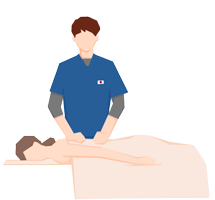diagnosed with lumbar intervertebral disc herniation and lumbar spinal canal stenosis, but improved with trigger point treatment of the gluteus medius
【female, 70s】
【female, 70s】



【female, 70s】
【female, 70s】
inability to walk. coldness and pain from below the right knee.
she was diagnosed with lumbar disc herniation between L4 and L5 and lumbar spinal canal stenosis after an MRI examination at an orthopedic clinic.
she is scheduled to be admitted to the hospital for tests and is told that surgery is a possibility.
she has suffered from the symptoms for about 3 months and has recently been unable to go out due to heavy pain.
she has both pain and numbness.
even when there is no pain, there is numbness.
the most numbness is in the right leg on the outside of the lower leg.
she came to us because she did not want to have surgery and wanted us to do everything, we could help her.
on visual observation, there was no problem, and on palpation, muscle tension was observed in the right gluteus medius muscle.
since there were no obvious symptoms such as numbness due to disc herniation or intermittent claudication due to spinal canal stenosis, i judged that the pain was caused by a trigger point in the muscle and focused my treatment on the trigger point in the gluteus medius muscle.
treatment area: gluteus medius muscle only
1st to 5th treatment: symptoms may worsen after treatment.
6th to 8th treatment: there will be a time when symptoms improve after treatment.
9th to 10th treatment: there will be a period when there are no numbness or pain symptoms.
11th treatment: Symptoms are completely gone, and walking is possible.
